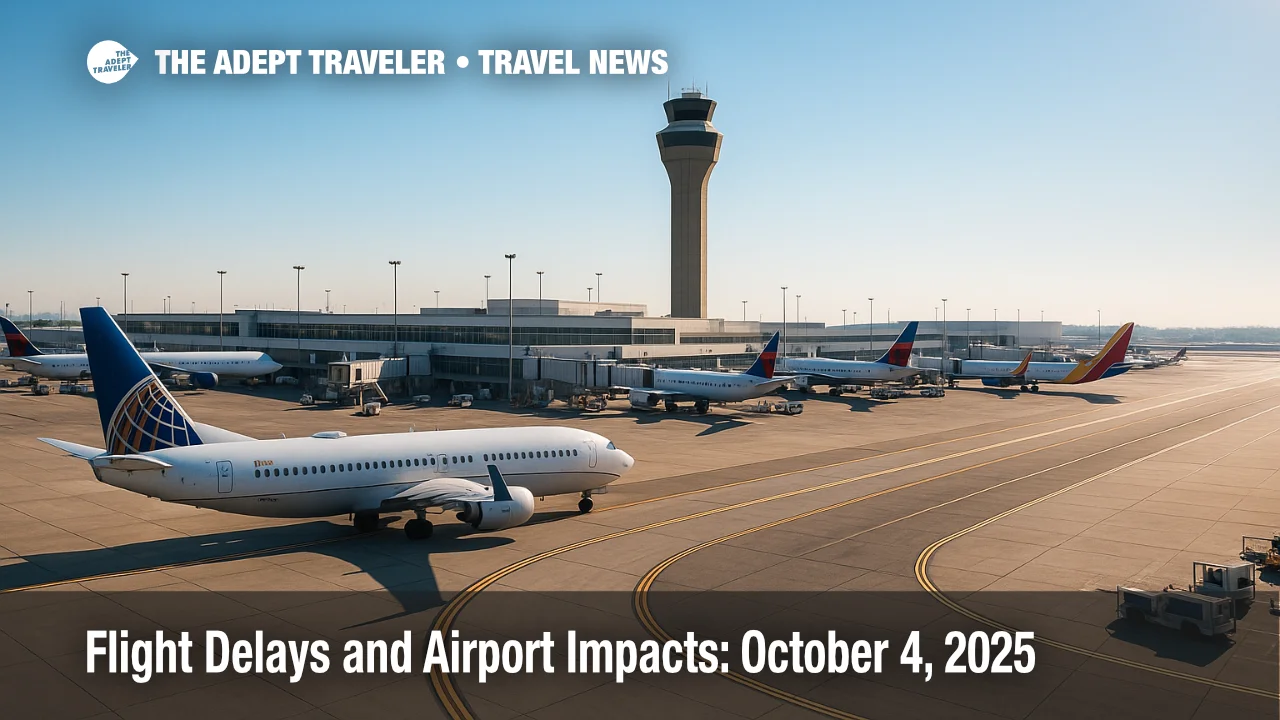Flight delays and airport impacts: October 4, 2025

A quiet-to-moderate start is expected nationwide, with the FAA noting no major weather concerns systemwide this morning. Staffing triggers are active for the Philadelphia region and Washington Center sectors, and South Florida, Seattle, San Francisco, Denver, and Houston face the highest chance of proactive traffic management later today. Travelers should watch for pop-up ground stops or delay programs if thunderstorms intensify around the Gulf and Atlantic corridors.
Key points
- Why it matters: Targeted delays are likely at several hubs during peak periods.
- Travel impact: Ground stops or delay programs are possible at MIA, FLL, SEA, SFO, DEN, and IAH.
- What's next: FAA planning webinar at 8:15 a.m. CDT will refine initiatives.
- Construction: Runway or taxiway closures continue at LGA, TEB, ORD, TPA, IND, IAH, MCO, SFO, BOS, and SAN.
- Routeing: Northeast to Central and Southwest Florida routes are in use early, with Gulf routes subject to closure if storms persist.
Snapshot
As of late morning, the Air Traffic Control System Command Center highlights staffing triggers in the Philadelphia area and portions of Washington Center, with a Northeast-to-Florida route structure active. Terminal weather flags include thunderstorms for Miami International Airport (MIA) and Fort Lauderdale-Hollywood International Airport (FLL), winds at Minneapolis-Saint Paul International Airport (MSP), and low ceilings or visibility at Seattle-Tacoma International Airport (SEA) and San Francisco International Airport (SFO). The FAA signals the potential for afternoon ground stops or delay programs at Miami, Fort Lauderdale, Seattle, San Francisco, and Denver International Airport (DEN), plus a late-evening ground stop at George Bush Intercontinental Airport (IAH). Construction-related runway or taxiway closures continue at multiple airports.
Background
The FAA publishes a rolling national operations plan each day to coordinate routes, staffing, and traffic management initiatives. When thunderstorms or low ceilings develop, the Command Center can implement ground delay programs, hold departures, or reroute flows along predefined corridors to maintain safety and throughput. Today's notes emphasize Florida and Gulf weather, potential low stratus on the West Coast, and ongoing construction at several busy airports. With the federal funding lapse that began on October 1, essential air traffic personnel remain on duty, but prolonged budget uncertainty can strain operations if employee availability tightens. Travelers should build in extra time during peak hours and monitor airline messages closely.
Latest developments
Thunderstorms could trigger Florida and Gulf slowdowns
The FAA's morning plan keeps Northeast-to-Florida routes active, with potential afternoon initiatives for arrivals into Orlando International Airport (MCO), Tampa International Airport (TPA), Miami, and Fort Lauderdale if storms blossom. Houston may see a late-evening ground stop if Gulf convection persists. West Coast marine layers could necessitate a ground stop or delay program at Seattle-Tacoma and San Francisco, especially around morning and evening push periods. Meanwhile, staffing triggers remain in effect for the Philadelphia area and parts of Washington Center, and construction closures continue at LaGuardia Airport (LGA), Teterboro Airport (TEB), O'Hare International Airport (ORD), Tampa, Indianapolis International Airport (IND), George Bush Intercontinental, Orlando, San Francisco, Boston Logan International Airport (BOS), and San Diego International Airport (SAN). No active Airspace Flow Programs are listed at this time.
Analysis
From a traveler's perspective, today's risks concentrate in three bands. First, Florida and the Gulf Coast, where scattered thunderstorms can force short-notice reroutes, compress arrival rates, and trigger brief ground stops, particularly mid- to late-afternoon when convection peaks. Second, the Pacific Northwest and Northern California, where low ceilings often reduce morning arrival acceptance rates at SEA and SFO; if ceilings linger, expect metered arrivals and minor holding. Third, targeted staffing constraints in the Northeast could add friction to corridor flows even without adverse weather. Construction-related runway closures at LGA and BOS, plus taxiway work at SFO and ORD, cut flexibility during peak banks and can amplify modest delays. While the national tone is not disruptive, the breadth of "possible" programs suggests a day of localized, rolling slowdowns instead of a single, nationwide choke point. Build a 60- to 90-minute buffer on connections touching South Florida, SEA, or SFO, and keep an eye on late-day operations at DEN and IAH if storms hold together.
Final thoughts
Expect a patchwork of manageable delays rather than a meltdown. Florida storms, West Coast low ceilings, and construction at key hubs will drive most of today's bumps, with staffing triggers adding some Northeast drag. If your itinerary touches Miami, Fort Lauderdale, Seattle, San Francisco, Denver, or Houston, enable flight alerts and consider earlier departures where possible. We will continue tracking ground stops, delay programs, and flow-constraining weather through the day in this flight delays and airport impacts report.
